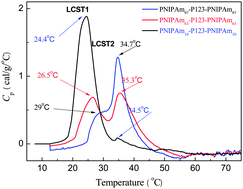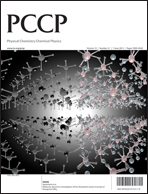The solution behaviors and microstructures of poly(N-isopropylacrylamide)x-poly(ethylene oxide)20-poly(propylene oxide)70-poly(ethylene oxide)20-poly(N-isopropylacrylamide)x (PNIPAmx-PEO20-PPO70-PEO20-PNIPAmx or PNIPAmx-P123-PNIPAmx) pentablock terpolymers with various PNIPAm block lengths in dilute and concentrated aqueous solutions were investigated by micro-differential scanning calorimetry (micro-DSC), static and dynamic light scattering (SLS & DLS), and synchrotron small angle X-ray scattering (SAXS). Two lower critical solution temperatures (LCSTs) were observed for PNIPAmx-P123-PNIPAmx pentablock terpolymers in dilute solutions, which corresponded to LCSTs of PPO and PNIPAm blocks, respectively. The LCST of PPO block shifted from 24.4 °C to 29 °C when the length x of PNIPAm block increased from 10 to 97. The LCST of PNIPAm is around 34.5 °C–35.3 °C and less dependent on the block length x. The PNIPAmx-P123-PNIPAmx pentablock terpolymers formed “associate” structures and micelles with hydrophobic PNIPAm and PPO blocks as cores and soluble PEO blocks as coronas in dilute aqueous solutions at 20 °C and 40 °C, respectively, regardless of the relative lengths of PNIPAm, PPO and PEO blocks. The size of “associate” structures of PNIPAmx-P123-PNIPAmx pentablock terpolymers at 20 °C increased with increasing the length of PNIPAm block. The microstructures of PNIPAmx-P123-PNIPAmx hydrogels formed in concentrated aqueous solutions (40 wt%) were strongly dependent on the environmental temperatures and relative lengths of PNIPAm, PPO and PEO blocks as revealed by SAXS. Increasing the length of PNIPAm block weakened the order structures of PNIPAmx-P123-PNIPAmx hydrogels. The microstructures of PNIPAmx-P123-PNIPAmx hydrogels changed from mixed fcc and hex structures for PNIPAm10-P123-PNIPAm10 to isotropic structure for PNIPAm97-P123-PNIPAm97. Increasing temperature led to the transition from mixed hex and fcc structure to pure hex structure for PNIPAm10-P123-PNIPAm10 hydrogel at temperature above the LCSTs.

You have access to this article
 Please wait while we load your content...
Something went wrong. Try again?
Please wait while we load your content...
Something went wrong. Try again?


 Please wait while we load your content...
Please wait while we load your content...